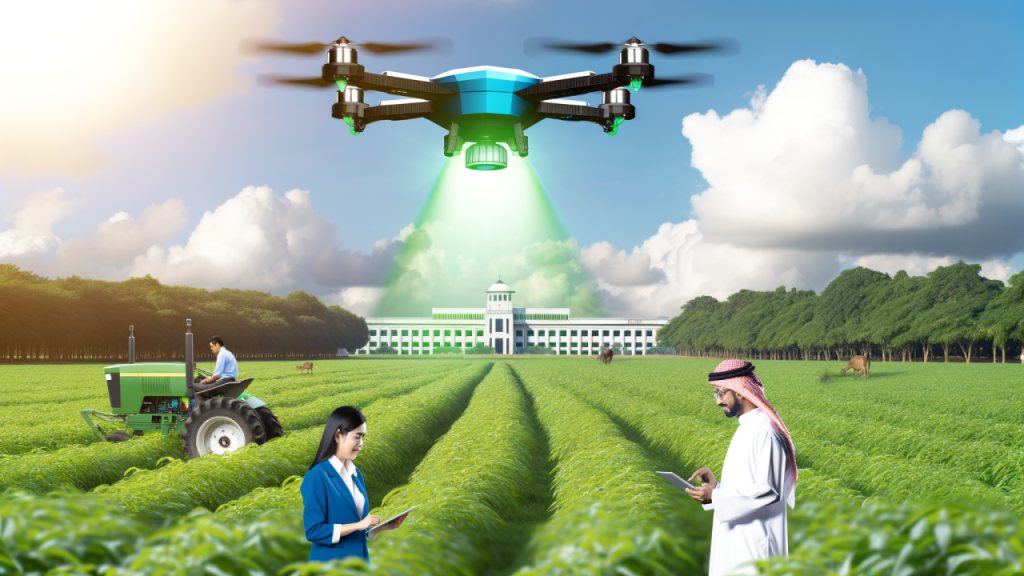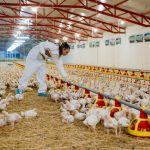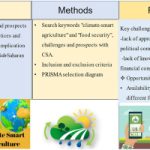Imagine a world where farms are not just vast expanses of land but hubs of innovation. A world where technology and nature work hand in hand to feed billions.
This isn’t science fiction; it’s the promise of smart agriculture. But how do we get there? The answer lies in how governments are stepping up to the plate, investing in technologies that transform traditional farming into a high-tech endeavor. You might wonder why this matters to you.
Well, the food on your table, the economy of your community, and even the health of our planet depend on these advancements. Governments around the world are recognizing this and are taking significant strides to support smart agriculture. Curious about how these efforts might affect your life? Read on to uncover the fascinating ways governments are paving the way for a smarter, more sustainable future in agriculture.

Policy Initiatives
Governments promote smart agriculture by investing in advanced technologies and sustainable practices. They provide funding and resources for research and development. These initiatives aim to boost productivity while ensuring environmental protection.
In the realm of smart agriculture, policy initiatives play a crucial role in shaping the future of farming. Governments worldwide are stepping up to support innovative farming practices, ensuring food security and environmental sustainability. As you delve into these policy initiatives, you might wonder how they impact the agricultural landscape and what you can learn from them.Government Grants And Subsidies
Governments often provide financial support to farmers adopting smart agricultural technologies. This can include grants for purchasing advanced equipment or subsidies for sustainable farming practices. Imagine the relief a farmer feels when they receive funds to invest in precision farming tools. Such initiatives empower farmers to innovate without the burden of financial constraints.Research And Development Support
Investing in research is a priority for many governments. By funding agricultural research, they pave the way for new technologies and practices. Consider the breakthroughs in crop genetics or pest management that have stemmed from such research. These discoveries can drastically improve yield and reduce losses, benefiting farmers directly.Educational Programs And Training
Educating farmers about smart agriculture is another key policy initiative. Governments often sponsor training sessions and workshops to help farmers understand and implement new technologies. Have you ever attended a workshop that opened your eyes to new possibilities? These educational programs can transform a farmer’s approach to agriculture, making them more efficient and productive.Regulatory Frameworks
Creating a supportive regulatory environment is essential for smart agriculture. Governments establish guidelines to ensure fair practices and protect the interests of all stakeholders. Imagine the clarity that comes with knowing you have legal backing for your innovative farming methods. This regulatory support encourages farmers to adopt smart agriculture with confidence. Collaboration between the government and private sector can lead to significant advancements in smart agriculture. These partnerships can drive innovation and improve infrastructure. Picture how a tech company working alongside the government can introduce cutting-edge tools to farmers. Such collaborations can accelerate the adoption of smart farming practices, benefiting the entire agricultural ecosystem. As you reflect on these policy initiatives, consider how they might influence your approach to smart agriculture. Are there opportunities for you to leverage these supports? Can you envision a future where smart farming becomes the norm, thanks to these government efforts?Financial Incentives
Smart agriculture is transforming how we grow and manage crops. Governments worldwide are backing this shift with financial incentives. These incentives aim to support farmers adopting modern technologies. They help cover costs and reduce financial risks. Let’s explore these incentives in more detail.
Tax Breaks For Smart Equipment
Many governments offer tax breaks for purchasing smart farming equipment. This reduces the initial investment burden on farmers. Tax incentives encourage the use of sustainable and efficient tools. Farmers can invest in drones, sensors, and automated systems. These tools improve productivity and reduce waste.
Grants For Research And Development
Government grants support research and development in smart agriculture. These funds help develop new technologies and farming methods. Grants are available for both public and private sectors. They foster innovation and practical solutions in agriculture. This support helps farmers stay competitive in a changing market.
Subsidies For Sustainable Practices
Subsidies promote sustainable agricultural practices. Farmers receive financial aid for adopting eco-friendly methods. These include organic farming, water conservation, and soil health improvement. Subsidies lower the cost of implementing these practices. They make sustainable farming more accessible and attractive.
Low-interest Loans For Farmers
Low-interest loans help farmers invest in smart agriculture. These loans offer better terms than traditional financing. They enable farmers to upgrade their equipment and infrastructure. By reducing financial strain, loans support long-term growth. Farmers can focus on innovation and efficiency.
Rebates For Technology Adoption
Rebates provide financial relief for technology adoption. Governments offer rebates for integrating smart systems. Farmers receive compensation for using precision agriculture tools. These tools include GPS systems and real-time monitoring devices. Rebates make advanced technology more affordable for farmers.
Research And Development
Governments boost smart agriculture by funding innovative research and development. They provide grants for sustainable farming practices and technology. Collaboration with tech companies and universities enhances crop yields and resource efficiency.
Smart agriculture is rapidly transforming the way we grow food, and governments worldwide are stepping up their support through research and development initiatives. This focus on innovation aims to make farming more efficient, sustainable, and resilient to climate change. You might wonder how these efforts impact you and your community. Let’s explore the ways governments are driving smart agriculture forward through strategic research and development.Investing In Agricultural Research Centers
Governments are establishing dedicated research centers to tackle the challenges of modern agriculture. These centers serve as hubs for innovation, bringing together experts to develop cutting-edge technologies. Imagine a local farming community gaining access to breakthroughs in pest control or drought-resistant crops. These advancements directly benefit farmers, enhancing productivity and reducing costs.Collaborations With Universities
Collaboration between governments and universities is key to smart agriculture. Universities offer a wealth of knowledge and resources, making them ideal partners in research endeavors. Picture professors and students working alongside government scientists to solve real-world farming issues. Such partnerships lead to practical solutions that can be implemented on farms across the globe.Funding Innovative Projects
Governments are allocating funds to support innovative agricultural projects. These investments encourage entrepreneurs and researchers to think outside the box. Consider a startup developing a smart irrigation system that conserves water while boosting crop yields. With government backing, these projects have the potential to revolutionize farming practices and improve food security.Encouraging Public-private Partnerships
Public-private partnerships are crucial for advancing smart agriculture. Governments are encouraging collaboration between private companies and public institutions to maximize resources and expertise. Imagine a tech company working with a government agency to create precision farming tools. This synergy leads to innovations that can transform agriculture and benefit farmers worldwide.Evaluating Impact And Progress
Research doesn’t stop at development; governments are committed to evaluating the impact of these initiatives. They assess progress to ensure that investments are yielding tangible benefits. Think about the importance of knowing whether a new crop variety truly increases yields or reduces environmental impact. Such evaluations are essential for refining strategies and ensuring long-term success. Research and development in smart agriculture are not just about technology; they’re about creating a sustainable future for farming. As you consider these efforts, ask yourself: How can these advancements change the way we think about food production? Governments are paving the way for a new era in agriculture, and you have a front-row seat to witness these exciting changes.
Public-private Partnerships
Public-Private Partnerships are transforming the agricultural landscape. Governments and private entities join forces. They aim to boost smart agriculture. These collaborations bring innovation and efficiency to farming. Farmers benefit from advanced technology and resources. This partnership model promises sustainable growth and food security.
How Governments Facilitate Partnerships
Governments create favorable policies. They support collaborations with private firms. These policies attract investments in smart farming. Governments offer tax breaks and grants. They ensure the private sector invests in agriculture. The aim is to encourage technological advancements. Farmers gain access to modern tools and practices.
Role Of Private Sector In Smart Agriculture
Private companies drive technology adoption. They introduce smart tools and solutions. These include sensors, drones, and AI systems. Companies work with farmers to enhance productivity. They provide training and support. This collaboration helps farmers use technology effectively.
Benefits Of Public-private Partnerships In Agriculture
Partnerships improve crop yields and quality. Farmers use better seeds and techniques. Smart agriculture boosts efficiency and reduces waste. It promotes environmentally-friendly practices. Farmers learn sustainable methods. This ensures long-term agricultural viability.
Challenges And Solutions
Partnerships face challenges like funding and technology access. Governments and companies work to overcome these. They provide resources and training. They ensure farmers benefit from smart agriculture. Collaboration is key to addressing issues.

Conclusion
Smart agriculture receives essential support from governments worldwide. This backing helps farmers adopt modern techniques. Financial aid and training programs make technology more accessible. Policies promote research and development in agriculture. These efforts aim to increase productivity and sustainability. Farmers benefit from improved resources and knowledge.
Challenges remain, but progress is visible. Support continues to grow for future advancements. Governments play a key role in shaping the future of farming. Together, these initiatives contribute to food security and environmental protection. The journey toward smarter farming is ongoing and promising.



